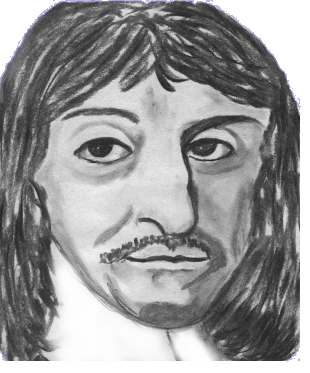
| |

René Descartes
The French mathematician and philosopher René Descartes, or Renatus des Cartes as he called himself in his Latin publications, lived during the early 17th century. He studied law, but since he had rich parents he never had to earn any money with his learned profession.
In Descartes' time, there was a new interest in geometry. Already the Greeks had studied perfect
shapes like the line, the circle or conic sections
and the curves which derive of it. Now it got important to know more about
curves, for example to study the path of
projectiles when shot from cannons, or to
design lenses used in telescopes and
microscopes.
Descartes and Fermat found a way to describe curves in an arithmetic way. They developed a new method called coordinate geometry. It was basic for the future devolpment of science.
 "I have resolved to quit only abstract
geometry, that is to say, the consideration of questions which serve only to exercise the mind,
and this, in order to study another kind of geometry, which has for its object the explanation of
the phenomena of nature."
"I have resolved to quit only abstract
geometry, that is to say, the consideration of questions which serve only to exercise the mind,
and this, in order to study another kind of geometry, which has for its object the explanation of
the phenomena of nature."
In coordinate geometry a coordinate system is used to assign to each point in a plane two values which determine its position. The position of a point P on a curve can be described by two numbers, px and py. These numbers, called abscissa and ordinate, are the distances between the point and two arbitrarily chosen but fixed axis.
Lets look at an example which shows how we can describe a geometrical shape using an algebraic equation:
The circle is probably the most perfect geometrical shape. The equation to describe it is beautiful and easy to find once you know the Pythagorean Theorem. Each point of this very special curve has the same distance from the circle's . This distance is the circle's radius.
Take a look at the animation on the left. You can see the two axes and the circle with its radius. From every point of the circle we can form a right triangle and describe it with its x and y coordinate. The red line shows the abscissa and the turquoise line shows the ordinate.
The Pythagorean Theorem states that the square of the radius has to be of the same area as the sum of the point's coordinates squared:
All the points with coordinates x and y which are described by this equation
are positioned on a circle which has the radius r and the center on the intersection
of the two axes.
Descartes was also an influential philosopher. He tried to explain the whole world through logical thinking. He started with doubting everything and then building up on axioms as it had been done in geometry since the time of the Greeks. He stated one of his axioms in his famous sentence "I think, therefore I am". Once he had proved with this sentence that he existed, he assumed that everything which people can have a clear picture of, has to exist too. Since his idea of God was of a perfect being, knowing everything, and being able accomplish whatever he wanted to, he concluded that God had to exist These ideas could not be deducted from the physical world, but come only from God. In Descartes' time, this was a very important conclusion. Scientists were very religious and highly motivated to find the laws behind nature as a way to glorify God.
With his system to explain the world, he "proved" many things, among others that animals could not feel like humans do. He said that they were equivalents to machines. Apparently he got a bit lost in his mathematical and logical thinking, and never found the time to really look at an animal.
